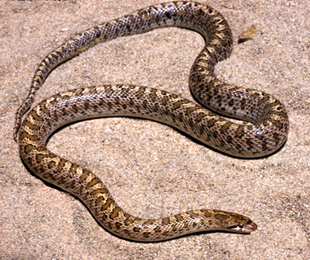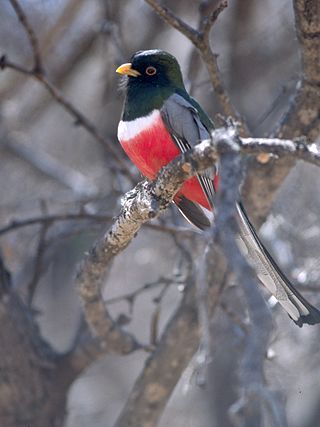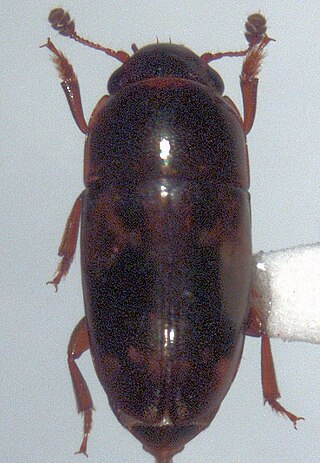
Caenorhabditis elegans is a free-living transparent nematode about 1 mm in length that lives in temperate soil environments. It is the type species of its genus. The name is a blend of the Greek caeno- (recent), rhabditis (rod-like) and Latin elegans (elegant). In 1900, Maupas initially named it Rhabditides elegans. Osche placed it in the subgenus Caenorhabditis in 1952, and in 1955, Dougherty raised Caenorhabditis to the status of genus.

The crimson rosella is a parrot native to eastern and south eastern Australia which has been introduced to New Zealand and Norfolk Island. It is commonly found in, but not restricted to, mountain forests and gardens. The species as it now stands has subsumed two former separate species, the yellow rosella and the Adelaide rosella. Molecular studies show one of the three red-coloured races, P. e. nigrescens, is genetically more distinct.

Bonitos are a tribe of medium-sized, ray-finned predatory fish in the family Scombridae – a family it shares with the mackerel, tuna, and Spanish mackerel tribes, and also the butterfly kingfish. Also called the tribe Sardini, it consists of eight species across four genera; three of those four genera are monotypic, having a single species each. Bonitos closely resemble the skipjack tuna, which is often called a bonito, especially in Japanese contexts.

Arizona elegans is a species of medium-sized colubrid snake commonly referred to as the glossy snake or the faded snake, which is endemic to the southwestern United States and Mexico. It has several subspecies. Some have recommended that A. elegans occidentalis be granted full species status.

Chamaedorea is a genus of 107 species of palms, native to subtropical and tropical regions of the Americas. They are small palms, growing to 0.3–6 m tall with slender, cane-like stems, growing in the understory in rainforests, and often spreading by means of underground runners, forming clonal colonies. The leaves are pinnate, with one to numerous leaflets. The flowers are produced in inflorescences; they are dioecious, with male and female flowers on separate plants. The fruit is an orange or red drupe 0.5–2 cm diameter. Perhaps the best-known species is Chamaedorea elegans from Mexico and Guatemala. It is popular as a houseplant, particularly in Victorian houses. Another well-known species is Chamaedorea seifrizii, the bamboo palm or reed palm.

The elegant trogon, previously known as the coppery-tailed trogon, is a near passerine bird in the trogon family native to Central America. The etymology of the word trogon comes from the Greek word trōgein, meaning "to gnaw", which describes how this species prepares its nests in trees.

The ring-tailed vontsira, locally still known as the ring-tailed mongoose, is a euplerid in the subfamily Galidiinae, a carnivoran native to Madagascar. It is the only species in the genus Galidia.

The yellow-throated bunting, also known as the elegant bunting, is a species of bird in the family Emberizidae.

The crested tit-warbler is a species of bird in the family Aegithalidae. It is found in China and possibly India. Its natural habitat is boreal forest. It generally has a red hint to it and a bit of blue on, or near, its wings. The tail is of an emerald green colour.

Byasa alcinous, the Chinese windmill, is a butterfly of the family Papilionidae.

Erythroneura elegans is a species of leafhopper in the family Cicadellidae.

Cryptarcha is a genus of sap beetles, insects in the family Nitidulidae.

Odontosia elegans, the elegant prominent, is a species of moth in the family Notodontidae. It was first described by Herman Strecker in 1885 and it is found in North America.

Isodontia elegans, also known as the elegant grass-carrying wasp, is a species of solitary, nest-provisioning, thread-waisted wasp in the family Sphecidae that hunts orthopterans.

Aeoloplides is a genus of spur-throated grasshoppers in the family Acrididae. There are about nine described species in Aeoloplides.

Pachyrhinus is a genus of pine needle weevils in the beetle family Curculionidae. There are more than 30 described species in Pachyrhinus.
Eulonchus tristis is a species of small-headed flies in the family Acroceridae.
Pachyrhinus ferrugineus is a species of broad-nosed weevil in the beetle family Curculionidae. It is found in North America.

Holbrookia elegans, the elegant earless lizard, is a species of lizard native to the United States and Mexico.
Padillothorus is a genus of jumping spiders in the family Salticidae containing the single species, Padillothorus elegans. It was first described by Jerzy Prószyński in 2018, and has only been found in Indonesia.

















